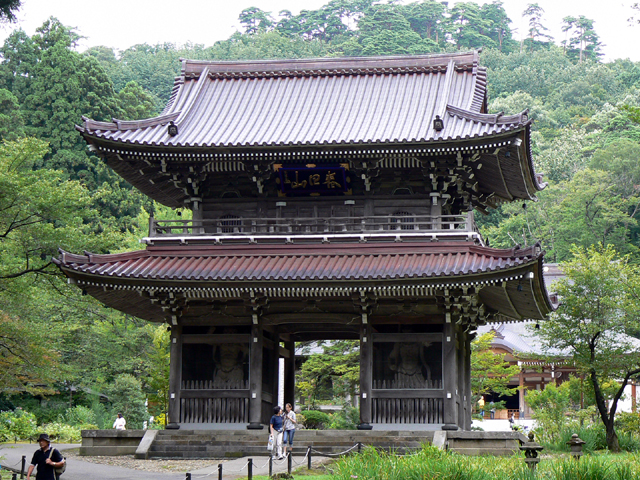|
Muroya Cave
is an archaeological site consisting of a Jōmon period cave dwelling in the Kamiya neighborhood of the town of Aga, Niigata Prefecture in the Hokuriku region of Japan. The site was designated a National Historic Site of Japan in 1980. Overview The cave is located deep in the mountains on the west bank of the Muroya River, one of the tributaries that flows north into the Agano River, which crosses the Echigo Mountains from east to west. It was formed by erosion of a rhyolite outcrop on the river's left bank at an elevation of 218 meters. The opening is to the south and faces a narrow river terrace on its east side. The cave is approximately three meters in height, seven meters in width and extends for eight meters into the mountain. The interior was excavated from 1960 to 1962 by the Nagaoka City Science Museum and the Niigata University School of Medicine, during which time numerous examples of Jōmon pottery from the earliest stage of the Jōmon Period and stone tools and scr ... [...More Info...] [...Related Items...] OR: [Wikipedia] [Google] [Baidu] |
Aga, Niigata
is a town located in Niigata Prefecture, Japan. , the town had an estimated population of 10,386 in 4490 households, and a population density of 11 persons per km2. The total area of the town is . Geography Aga is located in northeastern Niigata Prefecture. Covering 6.8% in area of the entire prefecture, Aga is the third largest municipality in Niigata after Jōetsu and Murakami. The Agano River and its tributary, the Tokonami River, flow through the center of the town. Surrounding municipalities Niigata Prefecture * Shibata * Agano * Gosen * Sanjō Fukushima Prefecture * Kitakata * Tadami * Nishiaizu * Kaneyama Climate Aga has a Humid climate (Köppen ''Cfa'') characterized by warm, wet summers and cold winters with heavy snowfall. The average annual temperature in Aga is . The average annual rainfall is with September as the wettest month. The temperatures are highest on average in August, at around , and lowest in January, at around . Demographics Per Japane ... [...More Info...] [...Related Items...] OR: [Wikipedia] [Google] [Baidu] |
Sue Ware
was a blue-gray form of stoneware pottery fired at high temperature, which was produced in Japan and southern Korea during the Kofun, Nara, and Heian periods of Japanese history. It was initially used for funerary and ritual objects, and originated from Korea to Kyūshū. Although the roots of Sueki reach back to ancient China, its direct precursor is the grayware of the Three Kingdoms of Korea. History The term ''Sue'' was coined in the 1930s by the archaeologist Shuichi Goto ( :ja:後藤守一) from a reference to vessels mentioned in the 8th century Japanese classical poetry anthology ''Man'yōshū''. Previous to this, the terms or ''Chosen doki'' were in more common use. Sue pottery is believed to have originated in the 5th or 6th century in the Kaya region of southern Korea, and was brought to Japan by immigrant craftsmen. It was contemporary with the native Japanese Haji pottery, which was more porous and reddish in color. Sue ware was made from coils of clay, bea ... [...More Info...] [...Related Items...] OR: [Wikipedia] [Google] [Baidu] |
Important Cultural Properties Of Japan
An The term is often shortened into just is an item officially classified as Tangible Cultural Property by the Japanese government's Agency for Cultural Affairs ( Ministry of Education, Culture, Sports, Science and Technology) and judged to be of particular importance to the history, arts, and culture of the Japanese people. Classification of Cultural Properties To protect the cultural heritage of Japan, the Law for the Protection of Cultural Properties was created as a under which important items are appropriated as Cultural Properties,In this article, capitals indicate an official designation as opposed to a simple, unofficial definition, e.g "Cultural Properties" as opposed to "cultural properties". thus imposing restrictions to their alteration, repair and export. Besides the "designation system", there exists a , which guarantees a lower level of protection and support to Registered Cultural Properties. Cultural Properties are classified according to their nature. Items ... [...More Info...] [...Related Items...] OR: [Wikipedia] [Google] [Baidu] |
History Of Niigata Prefecture
is a prefecture in the Chūbu region of Honshu of Japan. Niigata Prefecture has a population of 2,227,496 (1 July 2019) and is the fifth-largest prefecture of Japan by geographic area at . Niigata Prefecture borders Toyama Prefecture and Nagano Prefecture to the southwest, Gunma Prefecture to the south, Fukushima Prefecture to the east, and Yamagata Prefecture to the northeast. Niigata is the capital and largest city of Niigata Prefecture, with other major cities including Nagaoka, Jōetsu, and Sanjō. Niigata Prefecture contains the Niigata Major Metropolitan Area centered on Niigata with a population of 1,395,612, the largest metropolitan area on the Sea of Japan coast and the twelfth-largest in Japan. Niigata Prefecture is part of the historic Hokuriku region and features Sado Island, the sixth largest island of Japan in area following the four main islands and Okinawa Island. History Until after the Meiji Restoration, the area that is now Niigata Prefecture wa ... [...More Info...] [...Related Items...] OR: [Wikipedia] [Google] [Baidu] |

_MET_2015_300_259_Burke_website.jpg)

